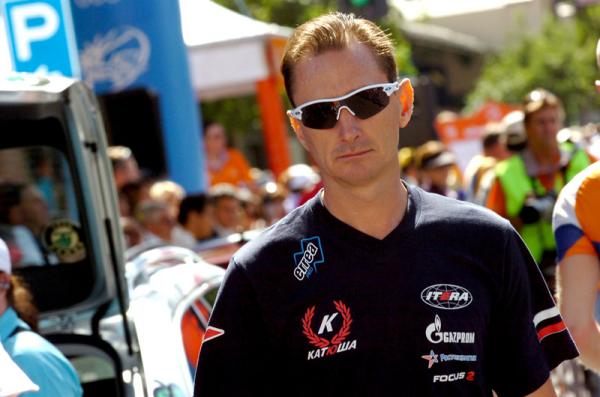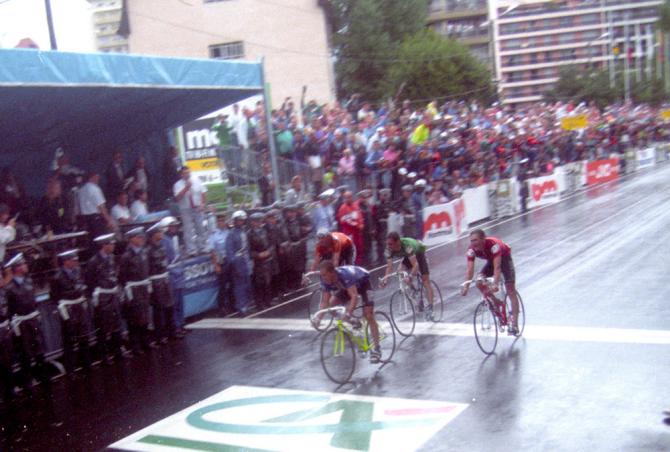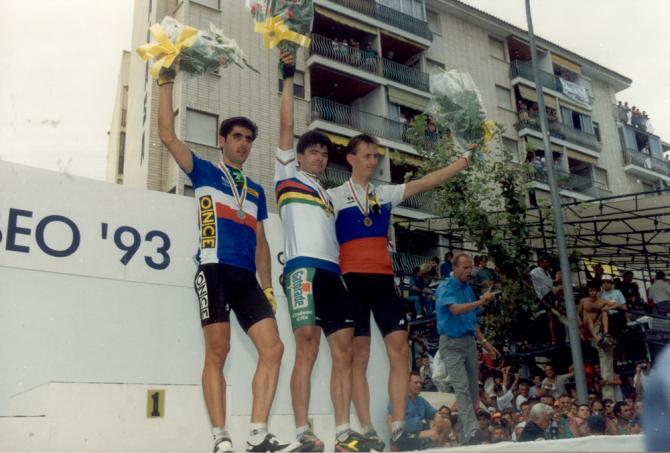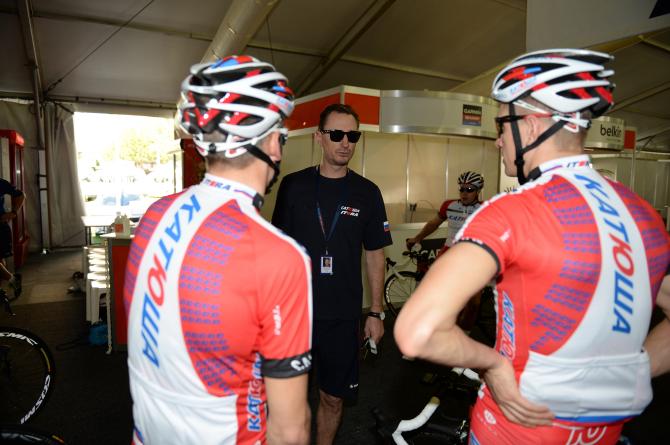Dimitri Konyshev: The silver hammer
The supposed playboy who claims to have been nothing of the sort




There is something about Dimitri Konyshev that makes grown-ups go gooey – and not just women. In fact, Konyshev has said on several occasions – and insists to us – he was never a ‘donnaiolo’ or ‘sciupafemmine’ as the Italians rather magnificently call the species known to us as the ‘ladykiller’.
“Okay, maybe people would see me out with a couple of women and they’d say that but I was in my early 20s,” he protests. “It would have been weirder if I hadn’t been out with girls. But Italians love this idea of a lothario….”
In fact, often with Konyshev, it was men who went weak at the knees. There was a nonchalance that emanated from him – something that suggested his rightful place wasn’t perched on the saddle of a bicycle but propped against a saloon bar, in brushed denim, a bourbon waiting on the counter and a Malboro dangling from his lips. When he pedalled, Konyshev and his machine flowed forward like a smooth tide. The legendary Italian commentator, Adriano De Zan, spent years watching Anquetil, Merckx, Hinault and Pantani – but only when Konyshev appeared on screen did the excited rasp of De Zan’s voice soften to a purr.
This year’s World Championship Road Race in Ponferrada marked a quarter of a century since Konyshev’s breakthrough on the international scene. His silver medal behind Greg LeMond in Chambéry was the first by a Russian or Soviet in the men’s Elite Road Race, in the USSR’s maiden participation. Konyshev was just 23 at the time. On a soaking Chambéry finishing straight, he left such aristocrats of pro cycling as Sean Kelly, Steven Rooks and Laurent Fignon floundering. The result itself was cause enough for hype; the race that preceded it had pundits drowning in superlatives.
One of the greats of Italian sports writing, Gian Paolo Ormezzano, wrote in La Stampa: “In what we confess is a real case of journalistic impotence, we’re struggling to recount the finale of the World Road Race Championship that took place yesterday in Chambéry, for fear of translating it into images that fail to do it justice. A comparison would be better: we’ve only seen a more beautiful sporting competition once, in the 10,000 metres at the 1971 European Athletics Championships in Helsinki, won by the Finn, Väätäinen. But how can we expect anyone to remember that?”
Twenty-five years on from what Ormezzano called “one of the most beautiful things we’ve ever seen in sport”, not even Konyshev’s memories are pin sharp. He has packed a lot of living into those two and half decades - too much, some would say. But, again, Konyshev will tell us that throughout his career he was miscast, that he was never the feckless playboy, the serial underachiever that he
was sometimes made out to be. He will assure us, in fact, that Chambéry raised expectations beyond the reach of his natural talent. Non-existent vices were simply how ill-informed journalists and directeurs sportifs explained away their misjudgement of his real potential.
Coming from the the Eastern Bloc
We meet him in a hotel bar in Alta, on the northern tip of Norway, deep inside the Arctic Circle. We are, of course, at the Arctic Race of Norway, where Konyshev, now the head directeur sportif at Katusha, will guide one of the local heroes, Alexander Kristoff,
to two stage wins. In a sense, Katusha is the modern-day scion of the team – Alfa Lum – in which Konyshev began his journey in professional cycling, and without which he’d perhaps never have raced in the European big leagues. The same applies to his countrymen and contemporaries Vladimir Poulnikov, Piotr Ugrumov, Djamolidine Abdoujaparov, Andrei Tchmil and Sergei Sukhoruchenkov.
Get The Leadout Newsletter
The latest race content, interviews, features, reviews and expert buying guides, direct to your inbox!
For Sukhoruchenkov, the ‘Merckx of the Eastern Bloc’, who was in his 30s when Mikhail Gorbachev began loosening the shackles of communism, it all came a little too late. Konyshev was different – above all, he was a decade younger and more fortunate. He had discovered cycling thanks to his father, a coach at one of the clubs in Nizhny Novgorod, although it could just as easily have been another sport: “My mum played basketball to a very high standard and I used to travel to matches with her,” Konyshev says. “I played everything, though – handball, basketball, volleyball. I found them all quite easy, really. In fact, cycling was the only thing that didn’t come naturally. In my early teens, I started going to my Dad’s training camps, trying to keep up and not managing. That really pissed me off, so I started training. Let’s say I quickly caught up after that….”
Konyshev had soon ditched his other sporting interests to specialise in cycling at one of the famed talent factories that produced generation upon generation of Eastern Bloc champions. Training was tough, he says, but nowhere near as arduous as the horror stories about youth sports behind the Iron Curtain have suggested. “In some places they did four training sessions a day: they’d be on the rollers before breakfast, then do a big road ride, then do a second session in the afternoon and rollers again in the evening. Ours wasn’t that brutal. In December, we’d do a nice training camp with long rides but slow – 180, 200, 220 kilometres to get your base. But then the next day you could rest. And we weren’t even that tired: you’d be rounding up people for a game of football on those rest days. There was no one screaming at us or beating us if we slacked off, plus the food and accommodation were absolutely perfect. We’d have caviar for breakfast!”
Hearing this, Konyshev’s critics might identify the origins of a champagne lifestyle. But he argues that they would be wrong.
Even when he won a Soviet National Championship when still a teenager, he was wrongly presented as a messiah when all he had really been was lucky. “They didn’t know me! I just came from behind and surprised everyone on an uphill finish. It was typical
of me: I just got lucky.”
How much is modesty, false or otherwise, is hard to tell. Konyshev summarises thus: “I was gifted only in the sense that Mother Nature didn’t give me a great physique or much of an engine. Whenever I started overloading myself with training, I was always getting sick, stomach problems or a sore throat. This was perhaps why people thought I didn’t train enough – I was fragile, but that was also what saved me and kept me going for so long. I never wore myself out.”
Konyshev’s performances made his protests of mediocrity harder to credit. In 1986, he left the Soviet Union for the first time and went to ride the Coors Classic and the World Championships in Colorado Springs. In America, he saw his first Chevrolets and Coca-Cola but was only mildly enamoured. “Some guys used those trips abroad to ‘escape’ and settle outside the Soviet Union but my head didn’t get turned.”
The following year, in 1987, he travelled to Italy and won three huge amateur races, the GP della Liberazione, the Giro delle Regioni and the Palio del Recioto. Then, in 1988, he took the Baby Giro. The most important overseas journey of 1988 from Konyshev’s point of view, though, was Mike Bruschi’s to Moscow to meet Gorbachev and the Soviet cycling federation. Bruschi owned Alfa Lum, a San Marino-based aluminium window and door-frame manufacturer which also sponsored a professional cycling team. Alfa Lum’s star rider, Maurizio Fondriest, was set to leave in 1989, which left Bruschi with a dilemma and an opportunity: one of his directeur sportifs, Primo Franchini, and the bike builder, Ernesto Colnago, had heard that a group of Soviet riders might turn pro as early as 1989. In Soviet cycling circles, indeed, a plan had begun to take shape almost as soon as Gorbachev came to power in 1985.
It even had a secret codename: ‘Project Sea Serpent’. Its ripples had travelled as far as San Marino and Bruschi was now willing to pay the Soviet federation four instalments of $100,000 for 15 of their riders. He would also pick up the tab for their food, lodgings and pocket money. The federation accepted and soon a delegation that included Poulnikov, Ugrumov, Abdoujaparov, Sukhoruchenkov and Tchmil was arriving in Rimini, on the Adriatic coast, to begin their adventure.
It’s fair to say that, initially at least, they didn’t take the pro scene by storm. At the first training camp at San Martino di Castrozza, Franchini said it was like conducting a silent orchestra: they would report for training every morning having already elected a spokesperson for the day and the rest wouldn’t open their mouths. They took Italian lessons – but initially were only interested in learning chat-up lines.
“I settled well in Italy because the Italians are such a warm and welcoming race but some of the other guys found it tough, especially the older ones with families,” Konyshev remembers. “And in races, the team didn’t really work. You can’t have a team consisting entirely of guys who have just turned pro. There was no cultural issue – in the USSR we were used to living with Tartars, Muslims, Armenians… But in the peloton it wasn’t easy. We hardly spoke any Italian. Plus, at the time the peloton was still a mafia. There was a sheriff who was in charge and told everyone what to do but they couldn’t do that with us. We pissed them off a bit for that reason; they couldn’t communicate with us, so we didn’t follow their orders.”
Chambéry Worlds
At the Worlds the Soviets at least had one advantage over the opposition: they had been racing together – admittedly unsuccessfully – since the start of the season. In Konyshev they also had a rider ideally suited to a tough Chambéry circuit plotted around the Côte de Montagnole climb. And Konyshev loved pretty much any kind of circuit race. “At races like the Tour of Flanders I’d still be asleep when the crucial break went. At the Worlds, it was easy: you just followed the wheels until the 200km mark, then you woke up and suddenly there would only be 20 riders left…”
That would be his game plan in subsequent Worlds but not here. After 100 kilometres, the Frenchman, Thierry Claveyrolat, and riders from five other major nations had formed the first significant break of the day - and Konyshev followed them. He can recall little of the next three or four hours, except that one by one his breakaway companions fell by the wayside. Having at one point led by five minutes, with 50 kilometres to go Konyshev and company had seen their advantage dwindle to just two minutes, and their group shrink to four members.
With 30 kilometres to go, suddenly, there were just two of them: Konyshev and Claveyrolat. A group containing all of the main favourites, among them Fignon and LeMond, was a minute back and closing.
A gripping race was nearing a magnificent denouement. It was just a shame that a fraction of the 100,000 paying spectators expected on the course had actually turned up. Many of those who were pressed against the barriers had snuck through hedges or unmanned gates, ticketless. Somewhere among them was the Soviet race leader’s father, who, Dimitri says, “had befriended a group of Italians and spent the entire day drinking with them”. He and his son didn’t seem in the least perturbed by skies which had turned grey, then black, and were about to unleash a biblical deluge. Or by the Dutchman, Steven Rooks, joining him and Claveyrolat with just over a lap to go.
An attack by Fignon on the final ascent of the Montagnole would end up dragging across two other heavyweights: Sean Kelly and the man who, only a month earlier, had inflicted the heartbreak of Fignon’s eight-second defeat in the Tour de France, Greg LeMond. Six riders would now contest the rainbow jersey in a sprint. Five of them were stars and one, Konyshev, was almost unknown except to assiduous followers of amateur racing.
When we ask Konyshev to talk us through the final kilometre, he tilts his head ruefully to one side and exhales. “I lost because I showed too much respect to Kelly, in particular. I saw that LeMond was going well and that he was following Fignon everywhere. The last time Fignon attacked was with one kilometre to go. LeMond closed, I jumped on his wheel but then saw Kelly and let him in. Then, when the sprint started, I had to pass Kelly and it was too much to come around LeMond as well.”
Konyshev is adamant that he harbours no regrets – even if only a few centimetres and a split second were all that came between him, LeMond and the American’s gold medal. “It’s not a big regret,” he says. “If I’d won that Worlds, I don’t know what would have happened. If you win the Worlds at 23…[grimaces]. Also, this was just a good example of me being lucky: I was in the break and they caught me – it’s not as though I stuck with them à la pédale. I wasn’t as strong as them, although a lot of people looked at the result, saw a 23-year-old finishing second in that field and thought I was a phenomenon.
“I’d have regrets later on, in other Worlds,” he goes on. “At Agrigento in 1994, when Luc Leblanc won, for example. I was the strongest there but got a piece of paper stuck in my sprockets on the last lap and my brake pad also started to rub. Same thing at Verona in 1999: I was the strongest guy in the lead group, saw Freire attack with 600 metres to go and expected the two Swiss guys to chase. But then no one knew Freire, either. It was a bit like me in 1989…”
With his silver medal in Chambéry, of course, Konyshev’s days of flying under the radar had drawn abruptly to a close. He was now being tipped as a future Tour de France winner, which was absurd for a rider who was more snow plough than ski-lift in the mountains. All of the Alfa Lum riders got a pay-rise in 1990 and, according to their directeur sportif, Franchini, it ruined them. “They were a pleasure to work with last year. Not any more. They only train when they feel like it,” Franchini said that February. At a pre-season training camp a few weeks earlier, Tchmil and another rider, Oleg Yaroshenko, had been caught trying to sneak back in through the window at breakfast time after a night on the tiles.
“They told us they didn’t know they had to sleep in the hotel where the training camp was being held!” Franchini sniffed. One rider, Vassili Jdanov, was at least honest enough to admit that many riders’ priorities had shifted in the space of a year. “What are we supposed to think of perestroïka and glasnost when life in Italy offers us a lot of other things? What do you expect? It’s normal that some guys want to take full advantage!” Franchini had classed Konyshev among those who were abusing their new status and lifestyle. He dropped his star rider for the Settimana Siciliana, by way of a reprimand. After similar warnings to other riders, they soon pepped up. Konyshev’s victory in a stage of the 1990 Tour de France to Pau was the first ever by a Soviet rider and the highlight of a gilded summer for Alfa Lum.
Konyshev would go on to collect three more Tour stages in a career that lasted into 2006, his 41st year. The most memorable, he tells us, was his victory on the Champs-Élysées in 1991, in a sprint most commonly remembered for the spectacular crash by his old team-mate, Abdoujaparov. He also won stages at the Giro and Vuelta and an assortment of Italian semi-Classics. The impression that he could have achieved even more persisted but so did the injuries and illnesses that he might have seen as a perverse blessing but looked to others more like a curse.
“I don’t consider myself to be a spurned talent,” he tells us by way of a conclusion.
“I think a lot of guys would be lucky to have my career and especially my career after retirement. Staying in this business for almost another 10 years after my last race is really an honour for me.”
With which Dimitri Konyshev gets up off his chair, shakes our hand and takes himself outside for a cigarette, as cool as the Arctic evening.
This feature appeared in the lastest issue of Procycling. Click here to subscribe.